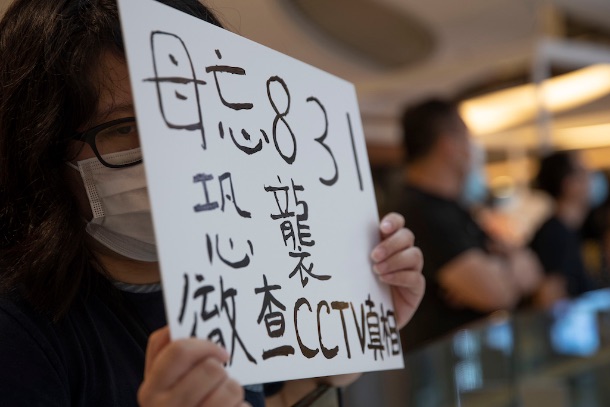Phonetic and orthographic confusion of Chinese characters
« previous post | next post »
A protester holds a placard that reads "Do not forget 831 terror attack, truth needs to be seen on CCTV" during a demonstration at a Hong Kong mall on Aug. 30 on the eve of the first anniversary of the Prince Edward MTR station incident when police stormed the station to make arrests during massive anti-government protests. (Photo: AFP)

(Source)
The sign says "Do not forget" or "Never forget", but it’s written 母忘 ("mother forget") instead of 毋忘 ("don't forget"). The shapes of the two characters are so similar that it is easy to mix them up. But the problem is compounded by the fact that they are pronounced similarly in Cantonese, which misled the writer in addition to visual similarity of the characters. In Cantonese mou4 毋 and mou5 母 sound very close.
Selected readings
- "The wrong way to write Chinese characters" (11/28/18)
- "'Spelling' errors in Chinese" (9/26/16)
- "Spelling mistakes in English and miswritten characters in Chinese" (12/18/12)
- "Mistakes in English and in Chinese" (2/13/18)
- "White dude challenges Chinese speakers in Shanghai" (5/5/17)
- "Writing characters and writing letters" (11/17/18)
- "Character Amnesia" (7/22/10)
- "Character amnesia revisited" (12/13/12)
- "Character amnesia redux" (4/22/16)
- "Spelling bees and character amnesia" (8/7/13)
- "Character amnesia and the emergence of digraphia" (9/25/13)
- "Dumpling ingredients and character amnesia" (10/18/14)
- "Character amnesia in 1793-1794" (4/24/14)
- "Japanese survey on forgetting how to write kanji" (9/24/12)
- "Kanji amnesia of the week" (7/25/20)
[Thanks to Bob Bauer and Abraham Chan]
Antonio L. Banderas said,
September 4, 2020 @ 1:47 pm
https://en.wiktionary.org/wiki/Appendix:Easily_confused_Chinese_characters
Chris Button said,
September 4, 2020 @ 8:28 pm
Although, historically speaking 毋 did come from 母 being used as a loangraph. So technically they're not incorrect, they're just inadvertently harking back to uses of yore.
jo lumley said,
September 7, 2020 @ 12:23 pm
Thanks to this post, I looked it up and discovered that even Japanese uses a character 毋 that is entirely separate from 母, though the former seems to appears in the Kojien dictionary only once, as one of several ways to write nakare (meaning something like 'must not').
The reason why this was a surprise (to me) is that the Japanese standardised characters use 毋 as a substitute for 母 when it is part of another character, like 毎、海、梅、毒 among others. Am I right in thinking that there are no common characters (or none at all..?) that in unsimplified form genuinely have 毋 as an element?
An aside: in principle the 母 → 毋 simplification doesn't apply to kanji not included on the list of permitted ones, so 'strawberry' is still supposed to be 苺 (or I guess it's 'supposed' to be written without the kanji at all), which has 母 underneath, not 毋.
Daniel Tse said,
September 7, 2020 @ 5:28 pm
Every time I arrive at Hong Kong International Airport, I see the characters 毋需申報 "Nothing to declare", while in most other contexts 無需 might be seen again. I always wondered whether this choice was due to formality/register, or some other conditioning factor?
Twill said,
September 8, 2020 @ 7:43 am
@jo lumley Not quite: while 毋 is not a common radical, 毒 is the orthodox Kangxi form of that character (which isn't going to change the fact that many people will write it with 母 nevertheless).
To say Japanese uses 毋 is a bit of a stretch; it's certainly hyougai, and as far as I'm aware it's never seen meaningful use outside of kanbun. 苺 is jinmeiyou, so it's officially recognized by the government, but couldn't be used in legislature.
jo lumley said,
September 8, 2020 @ 5:04 pm
Twill, you are right of course, it would be more accurate to say that all I found is that 毋 is listed in Japanese dictionaries which is not the same as actually being used. (Though up until then I had mistakenly thought of it as just a simplification of 母, rather than an actual separate character.)
As for 毒, that answers my question, thank you! I was somewhat misled by a cursory look at the examples on https://en.wiktionary.org/wiki/毒#Translingual where both Chinese printed versions clearly have 母 underneath, though that same page also makes the point that you did.